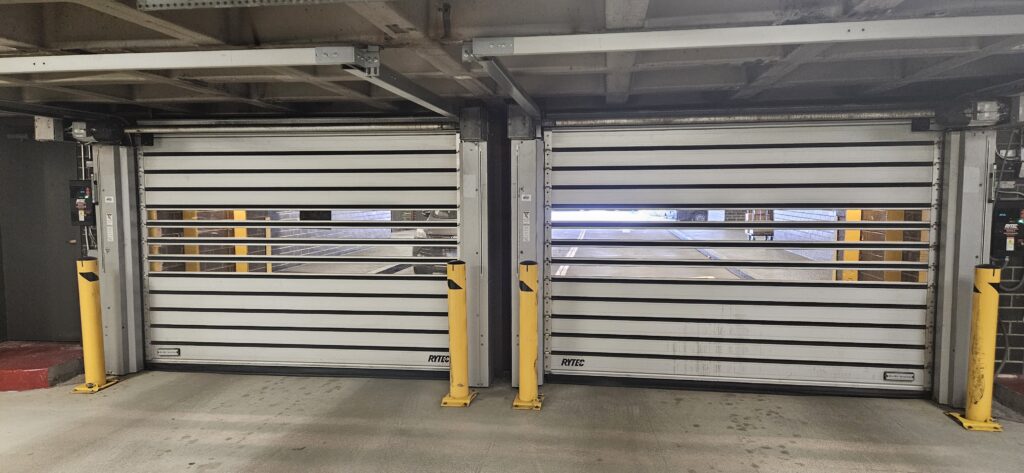Understanding Commercial Garage Door Installation
Commercial garage doors are essential for warehouses, industrial facilities, and businesses that require secure access. Unlike residential doors, commercial doors are heavier, larger, and often require specialized installation techniques.
Types of Commercial Garage Doors
Choosing the right garage door depends on the business’s needs. Below are the primary types:
Sectional Garage Doors
These are composed of multiple panels that open vertically, making them ideal for businesses with limited space.
Rolling Steel Doors
Constructed from steel slats, these doors roll up into a coil and are highly durable.
High-Speed Doors
Designed for high-traffic environments, these doors open and close quickly, improving efficiency.
Common Challenges in Commercial Garage Door Installation
Installed correctly, a commercial garage door presents several challenges.
Structural Requirements
Commercial doors require reinforced mounting structures due to their weight and size.
Electrical and Automation Setup
Many commercial doors integrate with automated systems, requiring electrical wiring expertise.
Signs That You Need Professional Help
- Misaligned door tracks
- Electrical malfunctions
- Difficulty operating the door manually
Step-by-Step Guide to Installing a Commercial Garage Door
A precise and methodical approach ensures a successful installation.
Step 1 – Preparing the Installation Site
Ensure the opening is level and the mounting surface is stable. Additionally, ensure there is adequate ceiling space to accommodate the installation of different types of garage door openers, such as trolley and jackshaft openers, to ensure safe and efficient operations.
Important Considerations for Step 1
- Measure door width and height accurately.
- Inspect the structural integrity of the mounting area.
Step 2 – Installing the Door Tracks
Secure the vertical and horizontal tracks properly to prevent misalignment. Ensure there is adequate room above, behind, and beside the door tracks to facilitate proper function and avoid operational issues during use.
How to Ensure Best Results in Step 2
- Use heavy-duty anchors and brackets.
- Verify track alignment before tightening bolts.
Step 3 – Assembling the Door Panels
Connect and fasten the door panels in sequential order.
Step 4 – Installing the Spring System
Torsion or extension springs help balance the door’s weight for smooth operation.
Step 5 – Connecting the Opener System
If a garage door opener is being used, mount and wire it according to the manufacturer’s instructions. There are various types of openers available, such as jackshaft, trolley, and hoist openers, each suited to different business needs and operational challenges.

Benefits of Installing a Commercial Garage Door
Investing in a high-quality garage door provides multiple advantages.
Security Enhancement
Commercial garage doors provide added security against break-ins. Safety features, such as sensors that can reverse a closing door when detecting nearby movement, are crucial in preventing harm to customers, employees, and vehicles.
Increased Energy Efficiency
Well-insulated doors reduce heating and cooling costs.
Durability and Low Maintenance
Heavy-duty materials ensure longevity and reduce repair costs.
Choosing the Right Commercial Garage Door
Selecting the appropriate door involves several factors.
Factors to Consider
Experience and Certifications
Choose a manufacturer and installer with industry certifications.
Customer Reviews and Reputation
Check online reviews and testimonials to gauge reliability.
Pricing and Service Guarantees
Compare quotes and ensure the company offers warranties.
Cost Breakdown for Commercial Garage Door Installation
Understanding the cost structure helps in budgeting.
Cost Factor 1 – Materials & Parts
The material type significantly influences cost (steel, aluminum, insulated, etc.). Adequate wall space is crucial for mounting commercial garage door openers, ensuring efficient operation and maintaining safety in business environments.
Cost Factor 2 – Labor and Installation Fees
Labor charges vary based on complexity and location.
DIY vs. Professional Installation: Which is Better?
DIY can save money but may lead to improper installation, resulting in long-term costs.
Maintenance & Long-Term Care for Commercial Garage Doors
Regular upkeep extends the door’s lifespan.
Regular Maintenance Tips
Cleaning and Lubrication
Use appropriate lubricants to prevent rust and ensure smooth operation.
Checking for Wear and Tear
Inspect for frayed cables, loose bolts, and worn-out rollers. It’s crucial to ensure that the garage door does not get stuck during operation to maintain safety and functionality.

Seasonal Adjustments
Adjust the tension in springs based on temperature changes.
When to Schedule Professional Inspections
A yearly inspection by a professional can prevent major repairs.
Conclusion
Proper installation of a commercial garage door enhances security, efficiency, and longevity. Whether you opt for DIY or professional installation, following best practices ensures smooth operation. If you need expert assistance, contact a trusted garage door service provider. More info at https://firstlinegarage.com/commercial-garage-doors/garage-door-for-storages/
Frequently Asked Questions (FAQs)
How much does it cost to install a commercial garage door?
Prices range from $1,500 to $7,000 depending on materials, size, and features.
How long does installation take?
Most installations take between 4 to 8 hours, but complex setups may require more time.
Do I need a professional or can I DIY?
Professional installation ensures safety and compliance with building codes, making it the preferred option.